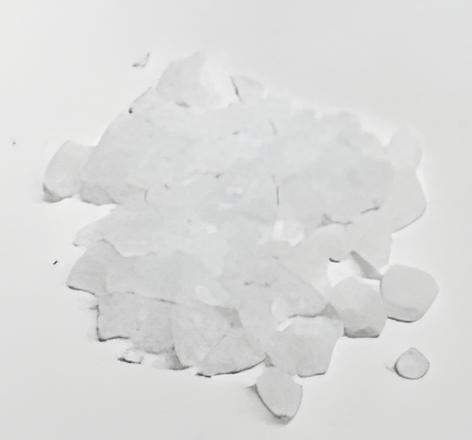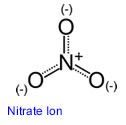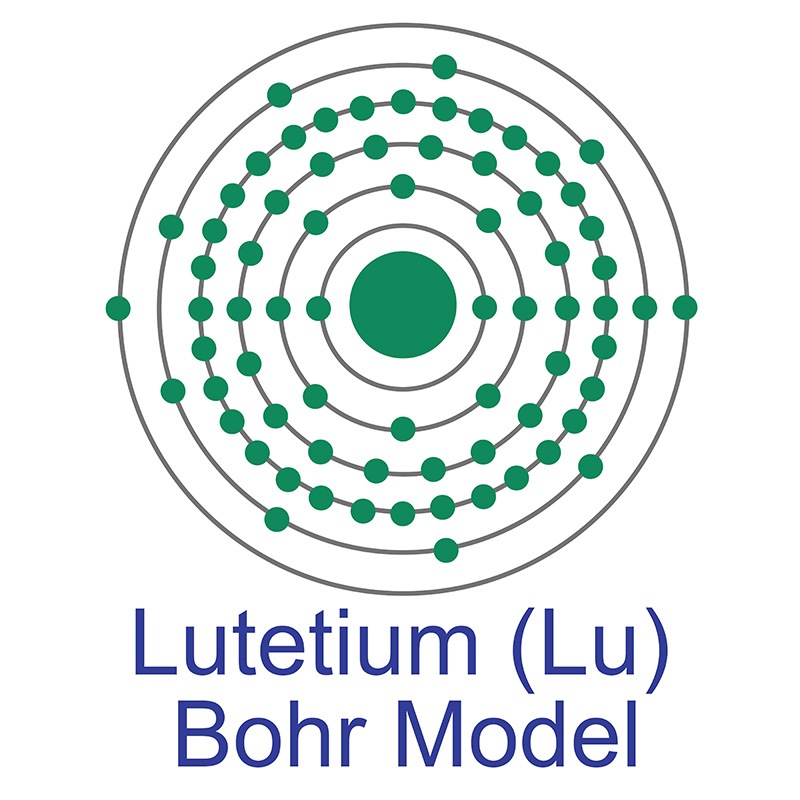SECTION 1. IDENTIFICATION
Product Name: Lutetium(III) Nitrate Hexahydrate
Product Number: All applicable American Elements product codes, e.g. LU-NAT-02-C.6HYD
, LU-NAT-03-C.6HYD
, LU-NAT-04-C.6HYD
, LU-NAT-05-C.6HYD
CAS #: 36549-50-5
Relevant identified uses of the substance: Scientific research and development
Supplier details:
American Elements
10884 Weyburn Ave.
Los Angeles, CA 90024
Tel: +1 310-208-0551
Fax: +1 310-208-0351
Emergency telephone number:
Domestic, North America: +1 800-424-9300
International: +1 703-527-3887
SECTION 2. HAZARDS IDENTIFICATION
Physical hazards Oxidizing solids Category 3
Health hazards Skin corrosion/irritation Category 2
Serious eye damage/eye irritation Category 2
Specific target organ toxicity, single exposure Category 3 respiratory tract irritation
Environmental hazards Not classified.
OSHA defined hazards Not classified.
Label elements


Signal word Warning
Hazard statement May intensify fire; oxidizer. Causes skin irritation. Causes serious eye irritation. May cause
respiratory irritation.
Precautionary statement
Prevention Keep away from heat. Avoid breathing dust/fume/gas/mist/vapors/spray. Wash thoroughly after
handling. Use only outdoors or in a well-ventilated area. Wear protective gloves/protective
clothing/eye protection/face protection.
Response IF ON SKIN: Wash with plenty of soap and water. Call a POISON CENTER or doctor/physician if
you feel unwell. If inhaled: Remove person to fresh air and keep comfortable for breathing. If in
eyes: Rinse cautiously with water for several minutes. Remove contact lenses, if present and easy
to do. Continue rinsing. If skin irritation occurs: Get medical advice/attention. If eye irritation
persists: Get medical advice/attention. Take off contaminated clothing and wash before reuse.
Storage Store in a well-ventilated place. Keep container tightly closed. Store locked up.
Disposal Dispose of contents/container to an appropriate treatment and disposal facility in accordance with
applicable laws and regulations, and product characteristics at time of disposal.
Hazard(s) not otherwise
classified (HNOC)
None known.
Supplemental information None.
SECTION 3. COMPOSITION/INFORMATION ON INGREDIENTS
Substances
Material name: LUTETIUM NITRATE, 99.9% HEXAHYDRATE
CAS number %
36549-50-5 100
SECTION 4. FIRST AID MEASURES
Inhalation
Move to fresh air. Oxygen or artificial respiration if needed. Call a physician if symptoms develop or persist.
Skin contact
Rinse skin with water/shower. Get medical attention if irritation develops and persists.
Eye contact
Immediately flush eyes with plenty of water for at least 15 minutes. Remove contact lenses, if present and easy to do. Continue rinsing. Get medical attention if irritation develops and persists.
Ingestion
Rinse mouth. If ingestion of a large amount does occur, call a poison control center immediately.
Do not induce vomiting without advice from poison control center. Get medical attention if symptoms occur.
Most important symptoms/effects, acute and delayed
Severe eye irritation. Symptoms may include stinging, tearing, redness, swelling, and blurred vision.
May cause respiratory irritation. Skin irritation. May cause redness and pain.
Indication of immediate medical attention and special treatment needed
Provide general supportive measures and treat symptomatically. Keep victim under observation.
Symptoms may be delayed.
General information
Take off all contaminated clothing immediately. Contact with combustible material may cause fire.
If you feel unwell, seek medical advice (show the label where possible). Ensure that medical personnel are aware of the material(s) involved, and take precautions to protect themselves. Wash
contaminated clothing before reuse.
SECTION 5. FIREFIGHTING MEASURES
Suitable extinguishing media
Water. Water fog.
Unsuitable extinguishing media
Do not use water jet as an extinguisher, as this will spread the fire.
Specific hazards arising from the chemical
Greatly increases the burning rate of combustible materials. Containers may explode when heated.
During fire, gases hazardous to health may be formed.
Special protective equipment and precautions for firefighters
Self-contained breathing apparatus and full protective clothing must be worn in case of fire.
Fire fighting equipment/instructions
In case of fire and/or explosion do not breathe fumes. Move containers from fire area if you can do so without risk. Use water spray to cool unopened containers.
Specific methods
Cool containers exposed to flames with water until well after the fire is out.
General fire hazards
May intensify fire; oxidizer. Contact with combustible material may cause fire.
SECTION 6. ACCIDENTAL RELEASE MEASURES
Personal precautions, protective equipment and emergency procedures
Keep unnecessary personnel away. Keep people away from and upwind of spill/leak. Keep out of low areas. Keep away from clothing and other combustible materials. Wear appropriate protective
equipment and clothing during clean-up. Do not touch damaged containers or spilled material unless wearing appropriate protective clothing. Ensure adequate ventilation. Local authorities should be advised if significant spillages cannot be contained. For personal protection, see section 8 of the SDS.
Methods and materials for containment and cleaning up
Eliminate all ignition sources (no smoking, flares, sparks, or flames in immediate area). Keep combustibles (wood, paper, oil, etc.) away from spilled material. Ventilate the contaminated area.
Stop the flow of material, if this is without risk.
Large Spills: Wet down with water and dike for later disposal. Shovel the material into waste container. Minimize dust generation and accumulation. Prevent entry into waterways, sewer, basements or confined areas. Following product recovery, flush area with water.
Small Spills: Sweep up or vacuum up spillage and collect in suitable container for disposal.
Never return spills to original containers for re-use. For waste disposal, see section 13 of the SDS.
Wear appropriate protective equipment and clothing during clean-up.
Environmental precautions
Avoid discharge into drains, water courses or onto the ground.
SECTION 7. HANDLING AND STORAGE
Precautions for safe handling
Keep away from heat. Minimize dust generation and accumulation. Routine housekeeping should be instituted to ensure that dusts do not accumulate on surfaces. Keep away from clothing and other combustible materials. Take any precaution to avoid mixing with combustibles. Avoid contact with eyes, skin, and clothing. Provide adequate ventilation. Wear appropriate personal protective equipment. Observe good industrial hygiene practices.
Conditions for safe storage, including any incompatibilities
Store locked up. Keep away from heat. Store in a cool, dry place out of direct sunlight. Store in original tightly closed container. Store in a well-ventilated place. Do not store near combustible materials. Store away from incompatible materials (see Section 10 of the SDS).
SECTION 8. EXPOSURE CONTROLS/PERSONAL PROTECTION
Occupational exposure limits
No exposure limits noted for ingredient(s).
Biological limit values
No biological exposure limits noted for the ingredient(s).
Appropriate engineering controls
Good general ventilation (typically 10 air changes per hour) should be used. Ventilation rates should be matched to conditions. If applicable, use process enclosures, local exhaust ventilation, or other engineering controls to maintain airborne levels below recommended exposure limits. If exposure limits have not been established, maintain airborne levels to an acceptable level. Eye wash facilities and emergency shower must be available when handling this product.
Individual protection measures, such as personal protective equipment
Eye/face protection
Wear safety glasses with side shields (or goggles).
Skin protection
Hand protection: Wear appropriate chemical resistant gloves. Suitable gloves can be recommended by the glove supplier. Frequent change is advisable
Other: Wear appropriate chemical resistant clothing.
Respiratory protection
In case of insufficient ventilation, wear suitable respiratory equipment.
Thermal hazards
Wear appropriate thermal protective clothing, when necessary.
General hygiene considerations
Keep from contact with clothing and other combustible materials. Remove and wash contaminated clothing promptly. Always observe good personal hygiene measures, such as washing after handling the material and before eating, drinking, and/or smoking. Routinely wash work clothing and protective equipment to remove contaminants.
SECTION 9. PHYSICAL AND CHEMICAL PROPERTIES
Appearance
Physical state Solid.
Form Crystalline.
Color White.
Odor Odorless.
Odor threshold Not available.
pH Not available.
Melting point/freezing point Not available.
Initial boiling point and
boiling range
Not available.
Flash point Not available.
Evaporation rate Not available.
Flammability (solid, gas) Not available.
Upper/lower flammability or explosive limits
Flammability limit - lower
(%)
Not available.
Flammability limit -
upper (%)
Not available.
Explosive limit - lower
(%)
Not available.
Explosive limit - upper
(%)
Not available.
Vapor pressure Not available.
Vapor density Not available.
Relative density Not available.
Solubility(ies)
Solubility (water) Soluble.
Partition coefficient
(n-octanol/water)
Not available.
Auto-ignition temperature Not available.
Decomposition temperature Not available.
Viscosity Not available.
Other information
Molecular formula Lu(NO3)3.6H2O
Molecular weight 469.07 g/mol
SECTION 10. STABILITY AND REACTIVITY
Reactivity Greatly increases the burning rate of combustible materials.
Chemical stability Material is stable under normal conditions.
Possibility of hazardous reactions Hazardous polymerization does not occur.
Conditions to avoid Heat. Contact with incompatible materials.
Incompatible materials Combustible material. Reducing agents.
Hazardous decomposition products May include oxides of nitrogen.
SECTION 11. TOXICOLOGICAL INFORMATION
Information on likely routes of exposure
Inhalation May cause irritation to the respiratory system.
Skin contact Causes skin irritation.
Eye contact Causes serious eye irritation.
Ingestion Expected to be a low ingestion hazard.
Symptoms related to the physical, chemical and toxicological characteristics
Severe eye irritation. Symptoms may include stinging, tearing, redness, swelling, and blurred
vision. May cause respiratory irritation. Skin irritation. May cause redness and pain.
Information on toxicological effects
Acute toxicity May cause respiratory irritation.
Skin corrosion/irritation Causes skin irritation.
Serious eye damage/eye irritation Causes serious eye irritation.
Respiratory or skin sensitization
Respiratory sensitization Not available.
Skin sensitization This product is not expected to cause skin sensitization.
No data available to indicate product or any components present at greater than 0.1% are
mutagenic or genotoxic.
Germ cell mutagenicity
Carcinogenicity This product is not considered to be a carcinogen by IARC, ACGIH, NTP, or OSHA.
IARC Monographs. Overall Evaluation of Carcinogenicity
Not listed.
US OSHA Hazard Categories (1)
Not regulated.
US OSHA Hazard Categories (10)
Not regulated.
US OSHA Hazard Categories (2)
Not regulated.
US OSHA Hazard Categories (3)
Not regulated.
US OSHA Hazard Categories (4)
Not regulated.
US OSHA Hazard Categories (5)
Not regulated.
US OSHA Hazard Categories (6)
Not regulated.
US OSHA Hazard Categories (7)
Not regulated.
US OSHA Hazard Categories (8)
Not regulated.
US OSHA Hazard Categories (9)
Not regulated.
US. National Toxicology Program (NTP) Report on Carcinogens
Not listed.
Reproductive toxicity This product is not expected to cause reproductive or developmental effects.
Specific target organ toxicity - single exposure
May cause respiratory irritation.
Specific target organ toxicity - repeated exposure
Not classified.
Aspiration hazard Not available.
SECTION 12. ECOLOGICAL INFORMATION
Ecotoxicity
Persistence and degradability No data is available on the degradability of this product.
Bioaccumulative potential No data available.
Mobility in soil No data available.
Other adverse effects No other adverse environmental effects (e.g. ozone depletion, photochemical ozone creation potential, endocrine disruption, global warming potential) are expected from this component.
SECTION 13. DISPOSAL CONSIDERATIONS
Disposal instructions
Collect and reclaim or dispose in sealed containers at licensed waste disposal site. Dispose of contents/container in accordance with local/regional/national/international regulations.
Local disposal regulations Dispose in accordance with all applicable regulations.
Hazardous waste code
The waste code should be assigned in discussion between the user, the producer and the waste disposal company.
Waste from residues / unused products
Dispose of in accordance with local regulations. Empty containers or liners may retain some product residues. This material and its container must be disposed of in a safe manner (see: Disposal instructions).
Contaminated packaging
Empty containers should be taken to an approved waste handling site for recycling or disposal.
Since emptied containers may retain product residue, follow label warnings even after container is emptied.
SECTION 14. TRANSPORT INFORMATION
DOT
UN number UN1477
UN proper shipping name Nitrates, inorganic, n.o.s. (LUTETIUM NITRATE)
Class 5.1
Transport hazard class(es)
Subsidiary risk -
Label(s) 5.1
Packing group III
Special precautions for Read safety instructions, SDS and emergency procedures before handling.
user
Special provisions IB8, IP3, T1, TP33
Packaging exceptions 152
Packaging non bulk 213
Packaging bulk 240
IATA
UN number UN1477
UN proper shipping name Nitrates, inorganic, n.o.s. (LUTETIUM NITRATE)
Class 5.1
Transport hazard class(es)
Subsidiary risk -
Packing group III
Environmental hazards No.
ERG Code 5L
Special precautions for Read safety instructions, SDS and emergency procedures before handling.
user
Passenger and cargo Allowed with restrictions.
aircraft
Other information
Cargo aircraft only Allowed with restrictions.
IMDG
UN number UN1477
UN proper shipping name NITRATES, INORGANIC, N.O.S. (LUTETIUM NITRATE)
Class 5.1
Transport hazard class(es)
Subsidiary risk -
Packing group III
Marine pollutant No.
Environmental hazards
EmS F-A, S-Q
Special precautions for Read safety instructions, SDS and emergency procedures before handling.
user
Transport in bulk according to N/A
Annex II of MARPOL 73/78
and the IBC Code
DOT: oxidizer 5.1
IATA; IMDG: 5.1
SECTION 15. REGULATORY INFORMATION
US federal regulations
TSCA Section 12(b) Export Notification (40 CFR 707, Subpt. D)
Not regulated.
CERCLA Hazardous Substance List (40 CFR 302.4)
Not listed.
SARA 304 Emergency release notification
Not regulated.
US OSHA Hazard Categories (1)
Not regulated.
US OSHA Hazard Categories (2)
Not regulated.
US OSHA Hazard Categories (3)
Not regulated.
US OSHA Hazard Categories (4)
Not regulated.
US OSHA Hazard Categories (5)
Not regulated.
US OSHA Hazard Categories (6)
Not regulated.
US OSHA Hazard Categories (7)
Not regulated.
US OSHA Hazard Categories (8)
Not regulated.
US OSHA Hazard Categories (9)
Not regulated.
US OSHA Hazard Categories (10)
Not regulated.
Superfund Amendments and Reauthorization Act of 1986 (SARA)
Immediate Hazard - Yes
Delayed Hazard - No
Fire Hazard - Yes
Pressure Hazard - No
Reactivity Hazard - No
Hazard categories
SARA 302 Extremely hazardous substance
Not listed.
SARA 311/312 Yes
Hazardous chemical
SARA 313 (TRI reporting)
Not regulated.
Other federal regulations
Clean Air Act (CAA) Section 112 Hazardous Air Pollutants (HAPs) List
Not regulated.
Clean Air Act (CAA) Section 112(r) Accidental Release Prevention (40 CFR 68.130)
Not regulated.
Safe Drinking Water Act Not regulated.
(SDWA)
US state regulations
US. California Controlled Substances. CA Department of Justice (California Health and Safety Code Section 11100)
Not listed.
US. Massachusetts RTK - Substance List
Not regulated.
US. New Jersey Worker and Community Right-to-Know Act
Not listed.
US. Pennsylvania Worker and Community Right-to-Know Law
Not listed.
US. Rhode Island RTK
Not regulated.
US. California Proposition 65
California Safe Drinking Water and Toxic Enforcement Act of 1986 (Proposition 65): This material is not known to contain any
chemicals currently listed as carcinogens or reproductive toxins.
International Inventories
Country(s) or region Inventory name On inventory (yes/no)*
Australia Australian Inventory of Chemical Substances (AICS) No
Canada Domestic Substances List (DSL) No
Canada Non-Domestic Substances List (NDSL) Yes
China Inventory of Existing Chemical Substances in China (IECSC) No
Europe European Inventory of Existing Commercial Chemical Substances Yes
(EINECS)
Europe European List of Notified Chemical Substances (ELINCS) No
Japan Inventory of Existing and New Chemical Substances (ENCS) Yes
Korea Existing Chemicals List (ECL) Yes
New Zealand New Zealand Inventory No
Philippines Philippine Inventory of Chemicals and Chemical Substances No
(PICCS)
United States & Puerto Rico Toxic Substances Control Act (TSCA) Inventory Yes
*A "Yes" indicates that all components of this product comply with the inventory requirements administered by the governing country(s)
A "No" indicates that one or more components of the product are not listed or exempt from listing on the inventory administered by the governing
country(s).
SECTION 16. OTHER INFORMATION
Safety Data Sheet according to Regulation (EC) No. 1907/2006 (REACH). The above information is believed to be correct but does not purport to be all inclusive and shall be used only as a guide. The information in this document is based on the present state of our knowledge and is applicable to the product with regard to appropriate safety precautions. It does not represent any guarantee of the properties of the product. American Elements shall not be held liable for any damage resulting from handling or from contact with the above product. See reverse side of invoice or packing slip for additional terms and conditions of sale. COPYRIGHT 1997-2022 AMERICAN ELEMENTS. LICENSED GRANTED TO MAKE UNLIMITED PAPER COPIES FOR INTERNAL USE ONLY.


 In its elemental form, lutetium has a silvery-white appearance. The lutetium atom has a radius of 174 pm and a Van der Waals radius of 221 pm. Lutetium was discovered and first isolated by Georges Urbain, Carl Auer von Welsbach and Charles James in 1906, all independently of each other.
In its elemental form, lutetium has a silvery-white appearance. The lutetium atom has a radius of 174 pm and a Van der Waals radius of 221 pm. Lutetium was discovered and first isolated by Georges Urbain, Carl Auer von Welsbach and Charles James in 1906, all independently of each other. Urbain was awarded the naming honor because he published his findings first. Lutetium is the last member of the rare earth series. Unlike most rare earths it lacks a magnetic moment. It has the smallest metallic radius of any
Urbain was awarded the naming honor because he published his findings first. Lutetium is the last member of the rare earth series. Unlike most rare earths it lacks a magnetic moment. It has the smallest metallic radius of any 
